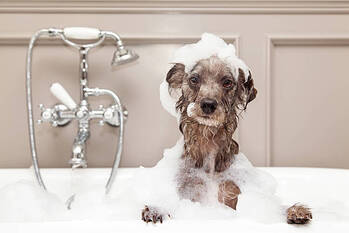|
Sept. 29, 2022 -- Dogs can detect when we are stressed, say the researchers behind a new study.
Dogs are known to be able to sniff out disease, such as cancer, malaria, and Parkinson’s disease. “Man’s best friend” is also able to detect the warning signs that a person is going to have an epileptic seizure, or a narcoleptic episode, or that their blood sugar is low, or that they are about to have a migraine. In a new study, published in PLOS ONE, researchers have found that dogs can detect changes in human breath and sweat associated with stress. And what’s more, the dogs can detect these changes with over 90% accuracy. The authors explained that "odors emitted by the body constitute chemical signals that have evolved for communication, primarily within species.” Given dogs' role in supporting human psychological conditions such as anxiety, panic attacks, and post-traumatic stress disorder (PTSD), the researchers wondered whether dogs could be sensing chemical signals to respond to their owners' psychological states. Trained and Tested For their study, researchers from Queen's University Belfast collected samples of breath and sweat before and after a fast-paced arithmetic task from non-smokers who had not recently eaten or drank. The self-reported stress levels and physiological measures, like heart rate and blood pressure, of the participants were also recorded. Pet dogs from the Belfast community were recruited, and from 20 dogs, four reached the testing phase. These four dogs were aged from 11 months to 2.25 years and were of different breeds and breed-mixes – cocker spaniel, cockapoo, and two undetermined breeds (lurcher-type and terrier-type). Using a clicker along with kibble, they were trained to match smells in a discrimination task. The authors said that performance at above 80% correct (chance level) was needed in the training stages before the testing stages started in order to be sure that if a dog's performance during the testing phase dropped to chance at the testing phase, this was because the stress and baseline samples were indistinguishable to the dog, and not because the dog "didn’t know how to do the task.” During the testing phase, the samples of 36 participants who reported an increase in stress because of the task, and who experienced an increase in heart rate and blood pressure during the task, were presented to trained dogs within 3 hours of being collected. Dogs were asked to find the participant's stress sample - taken at the end of the task. Also in the sample choices for the dogs were the same person's relaxed sample, which had been taken minutes prior to the task starting. Future Application The researchers found that dogs could detect and perform their alert behavior on the sample taken during stress in 675 of 720 trials, which equated to 93.75% of the time. "The first time they were exposed to a participant’s stressed and relaxed samples, the dogs correctly alerted to the stress sample 94.44% of the time," the authors said. Individual dogs ranged in performance from 90% to 96.88% accuracy. "This study demonstrates that dogs can discriminate between the breath and sweat taken from humans before and after a stress-inducing task," said the authors. An "acute, negative, psychological stress response" alters the odor profile of our breath and sweat, and dogs are able to detect this change in odor, they said. They explained that their findings provide even more information about the "human-dog relationship,” and that the findings could be applied to the training of anxiety and PTSD service dogs that are currently trained to respond mainly to visual cues.
0 Comments
A Pro Groomer's Top TIps on How to Properly Bathe a Dog. |
Archives
July 2024
Categories |


 RSS Feed
RSS Feed